To Go Back to MAIN Burtonwood Home Page Click Here To Go Back to Airfields Page Click Here
Gosling Camps Royal Naval
Training Establishment
 |
The United States
Air Force Badge
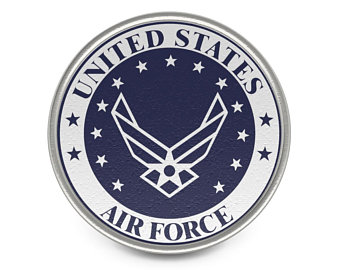 |
RAF Croft is located off lady lane croft 3.2 km northeast from the town center of Warrington.
This site is not to be confused with the RAF Croft located in North Yorkshire later to be renamed RAF Neasham.
Croft was originally constructed for the royal navy also at this period 4 other camps were being constructed for the navy
all within a few miles of each other within the Warrington borough all the camps becoming known as gosling camps
HMS Gosling camp 1- at new lane the headquarters at Croft, HMS Gosling camp 2- at Risley, HMS Gosling camp 3- at lady lane Croft HMS Gosling camp 4- at Lowton and HMS Gosling camp 5-at Glazebrook.
Croft became commissioned during July 1942 becoming the training facility for the royal naval fleet air arm mechanics center. After ww2 on the 21st of October 1947, the royal navy left and the site was decommissioned.
During the mid-1950s the site was renamed RAF Croft and at this time period the site became tenanted by the USAF united states air force as a transient base for American personnel and their dependents from nearby RAF Burtonwood.
During this time on the 1st February 1956 the 7500th airbase squadron under the umbrella of MATS military air transport services arrived at Croft for the handling of all American personnel arriving and departing the united kingdom by aircraft from and to the united states.
Croft was handling over 60,700 passengers a year, the passengers being transported between RAF Burtonwood and RAF Croft by bus. RAF Burtonwood operated a fleet of 35 single-decker buses with a capacity of 29 passengers each.
Croft operated 7 days a week 24 hours a day processing all personnel arriving and departing.
The camp could accommodate around 400 people many were processed straight through and others stayed for just one night. Facilities included a snack bar for sandwiches and beer, a movie theater and dance hall, nursery, and a 24 hour a day dining /mess hall.
Also available air passenger specialists, finance, postal, civilian fire brigade.bakers, cooks, and its own police force.
Overnight sleeping arrangements were in H-block type buildings sited on the north and south sides of the main building.
By 1959 the united states air force had left RAF Burtonwood and croft was no longer required any more, shortly after the h-block sleeping buildings were demolished, leaving the large area of the dining kitchen area, cinema, tower block and adjoining buildings intact.
The site was later sold off by the RAF to a local farmer who retained the surviving buildings to store his farming equipment in.
HMS gosling book
Ordnance survey map showing the main service buildings
in the middle with the h-block living buildings around the sides.
Aerial Photo of HMS Gosling/ RAF Croft June 2009
(Note the ring road around the main service buildings)
Legend for the photo above:
1 Armory and part of the kitchen area.
2 Kitchen
3 Living and accommodation H Blocks, these buildings were demolished between 1959 / 1961
4 Spine corridor, with small interlinked rooms leading off on each side of the corridor.
5 Bar area.
6 Cinema/theater and dance hall.
7 The tall brick tower block, the top of this building is constructed with large RSJs we think to support a high-level water tank.
8 Exercise and parade ground.
9 The pond used as an EWS emergency water supply for fire fighting purposes.
10 The original royal navy training classrooms later utilized post ww2 by the united states air force for other purposes.
11 The 2 parallel mess/ dining halls.
HMS Gosling 3 group training photo WW2 1944
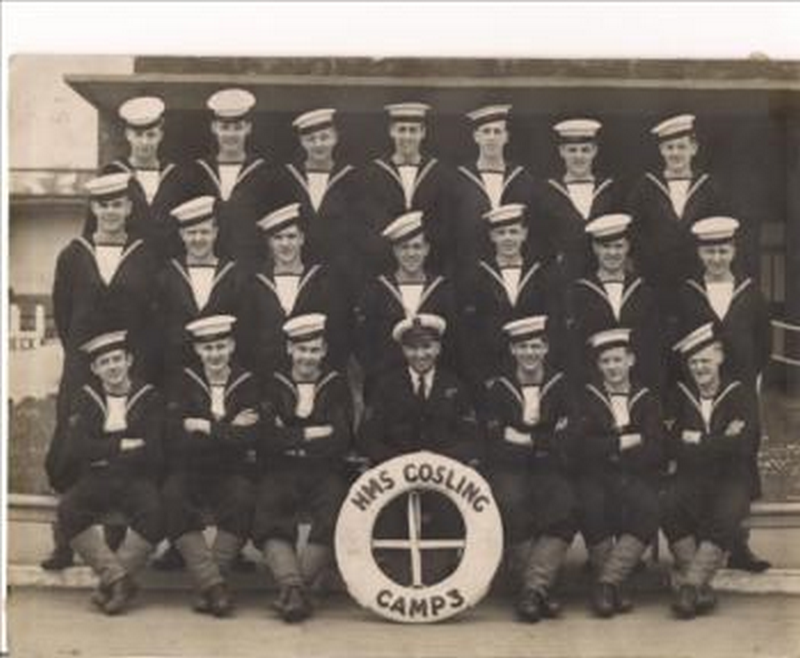 The same photo below (as above) taken from a different angle 68 Years
The same photo below (as above) taken from a different angle 68 Years
later was taken in 2012 outside the training classrooms
South facing door entrance

HMS Gosling 3 group training photo 3 April 1944.

HMS Gosling 3 group training photo,
course number - 86 - k3 8th March 1944
HMS Gosling 3 group training photo,
course number - 87 - e3 14 March 1944.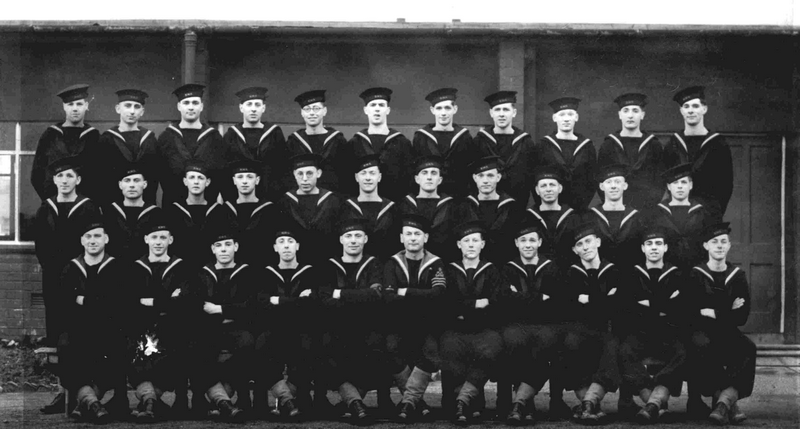 The same photo below (as above) taken from a different angle 68 Years
The same photo below (as above) taken from a different angle 68 Years
later was taken in 2012 outside the training classrooms
East facing door entrance
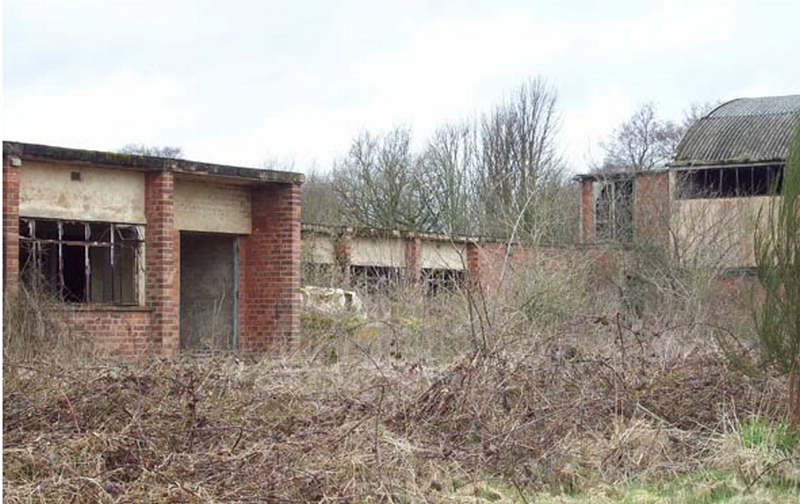
Group photo of Royal navy students at the HMS Gosling camp 3 training
establishment at lady lane Croft Warrington during world war 2.
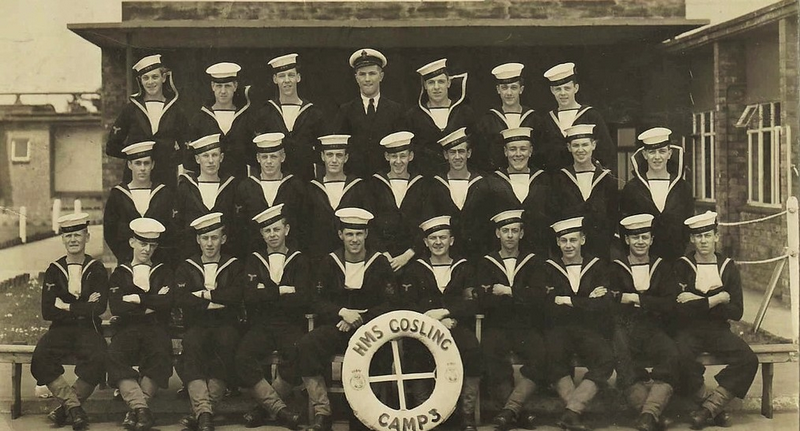 The same photo below (as above) taken from a different angle 68 Years
The same photo below (as above) taken from a different angle 68 Years
later was taken in 2012 outside the training classrooms
west facing door entrance
 Badge of the royal air force.
Badge of the royal air force.
The following 7 black and white photos of RAF Croft appeared
in the united states air force yearbook during the late 1950s.
Kitchen serving area.
Dining room.
Post office
kitchen
Dining hall
Inside one of the H block central heated
living accommodation buildings.
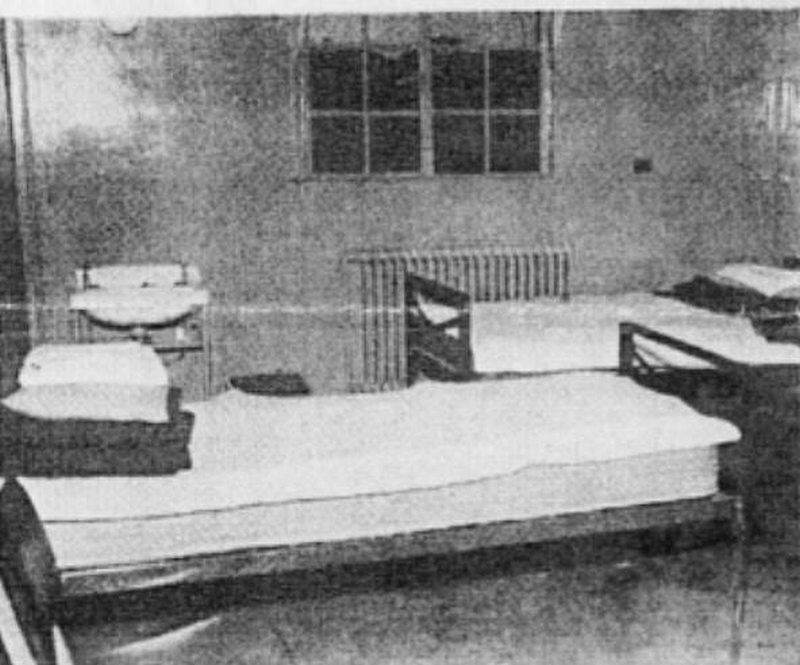
Children's Nursery
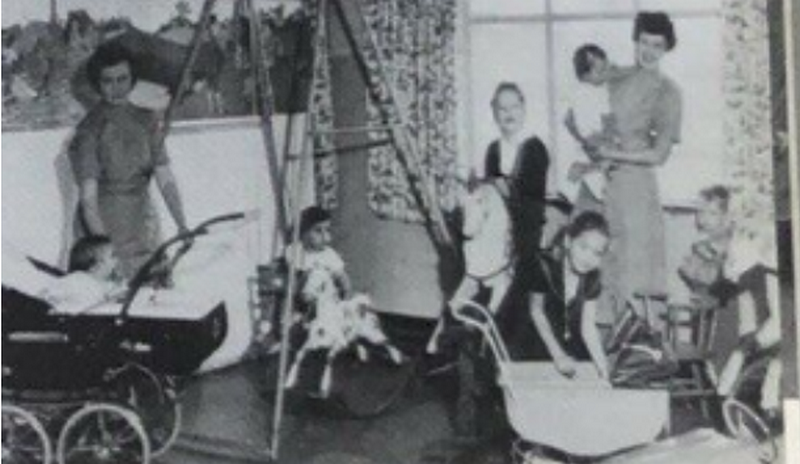
RAF Croft main entrance during 1956
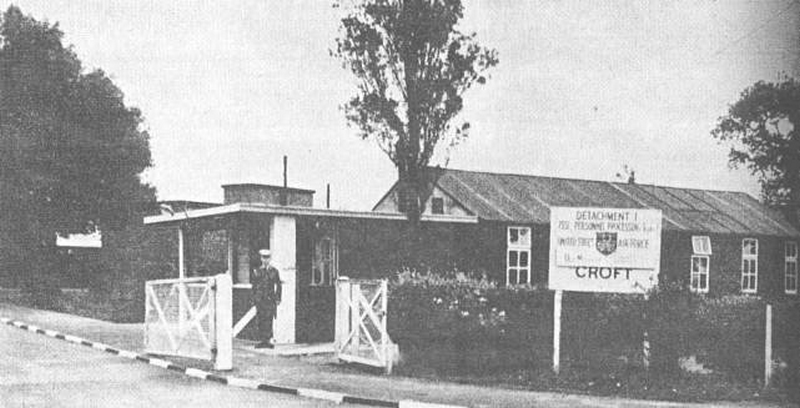
RAF Croft main entrance during 2001

RAF Croft main entrance at the
time of demolition during 2013
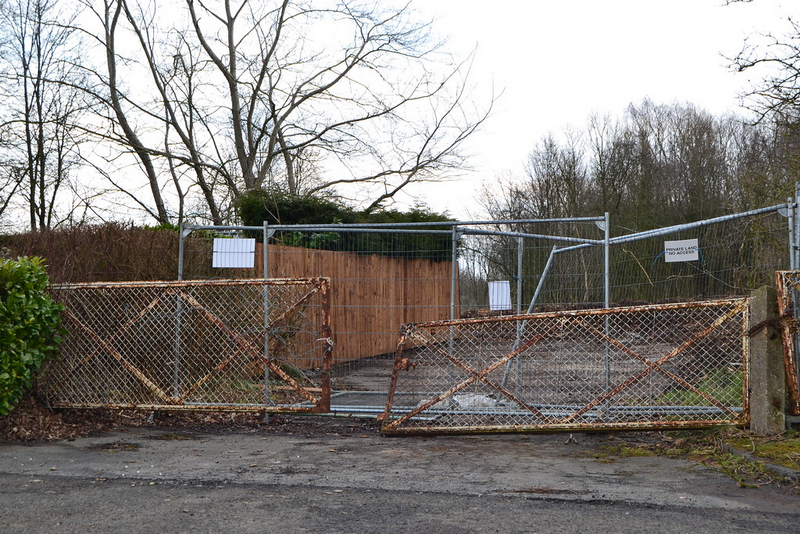
The main entrance gates still survive today
at the RAF Burtonwood heritage centre.
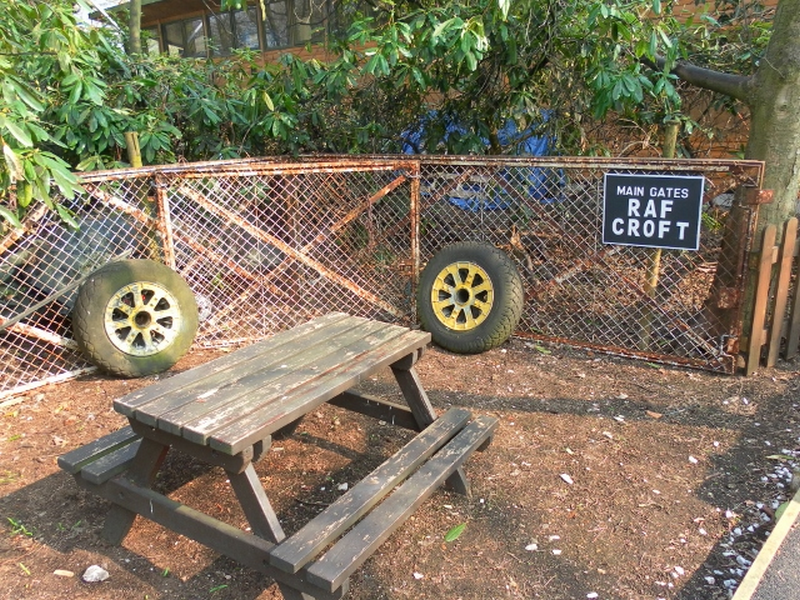
No record site plan or building records in the royal naval and royal
air force archives are available for in-depth research of the site
Entering the site by the main gate at lady lane traveling east is the main entrance building constructed of brick that was used as a store and an armory.
Built on to the roof of this building is a large brick enclosure housing a large gravity supply water tank.
This building is joined to the main kitchens that were originally fitted with white tiled walls, the kitchen is alined longways south to west, this kitchen building connects to the 2 parallel dining mess rooms both aligned east to west longways.
The construction of the kitchen and dining rooms are of brick laid in stretcher bond to a height of 9 feet then with sheet cladding up to roofline height.
All 3 of these buildings are the same design and are steel-framed supporting a curved steel profile roof coved with corrugated sheets.
Metal framed windows are fitted around the walls for natural light, these buildings also had mechanical ventilation.
At the end of the dining rooms is a spine corridor with interlinked small rooms on the north and south sides.
The spine corridor and small rooms are single storeys high constructed in brick built-in stretcher bond, the brick walls support a flat reinforced concrete roof covered in asphalt/bitumen for waterproofing, the corridor is dark with no natural light but the side rooms have some windows.
Traveling east to the end of the spine corridor and turning right leads into 2 large single storey rooms, we are not quite sure of the purpose of the 2 rooms but we think they might have been used as part of the bar area as lounges /restrooms.
Or possibly training classrooms during the Royal Navy Occupation.
The rooms are fitted with steel-framed windows along the east and west elevations for natural light, the roofs are again flat.
Turning left at the end of the spine corridor leads into the bar area, and theatre building this building also being used as the cinema and dance hall.
The cinema building has been constructed to the same design as the kitchen and dining halls buildings, the north and south elevations of this building are fitted with rows of steel-framed windows just under the roofline.
The building also contained a stage and the projection room the finished floor area being constructed of woodblock.
Built onto the east end of the cinema is a tall tower block building constructed out of brick, the upper part of the tower block is inaccessible but looks to have contained a plant room for the heating plant and air handling units for the cinema.
As an example, the nearby gosling camp 5 at Glazebrook has been constructed with the same design tower block and is explorable.
There is no evidence of any boiler houses or rising chimneys on-site, there would have been some type of heating system for heating the main facility and the H-block living accommodation buildings.
We think the site was constructed with district heating being supplied with 1 central boiler house that was probably demolished at the same time as the H-blocks.
Evidence of the final sub-circuit electrical installation still remains being installed in metal trunking with steel conduit fitted to the ceilings and walls.
Supplying power and lighting wired in TRS stranded singles cables, switchgear, sockets, and switches being constructed of cast iron.
The site was constructed with a tarmac perimeter loop road with the main service buildings in the middle and the H-block accommodation buildings on the north and south side of the perimeter road.
The former H-block accommodation buildings were demolished together with the air raid shelters in the late 1950s but before 1961.
Also in this eastern area was the camp exercise and parade ground also a large pond there was used as a static water tank, EWS emergency water supply for the use of fire fighting purposes.
Main front entrance of the facility looking east, this building contained the armoury and kitchen store.
The building constructed above is the housing for a gravity feed water tank, all brickwork on site is built in stretcher bond.
 Looking north, to the left, is the armoury and kitchen store
Looking north, to the left, is the armoury and kitchen store
with the tank room on the roof to the right can be
seen the curved profile roof of the kitchens.
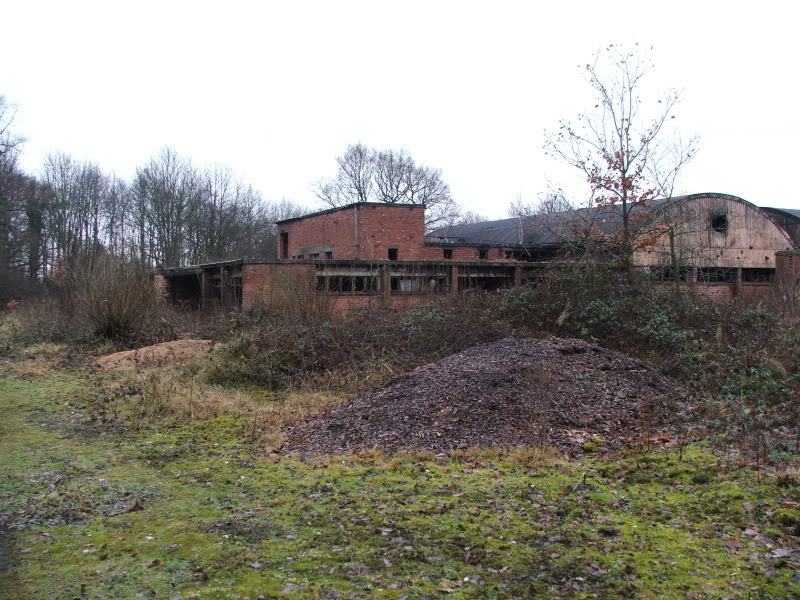 Information board fitted on the north-facing sidewall of the
Information board fitted on the north-facing sidewall of the
dining hall the building to the right is the kitchens.
 The north-facing sidewall of the dining hall but at the east
The north-facing sidewall of the dining hall but at the east
end, there are 2 of these dining rooms in parallel rows.
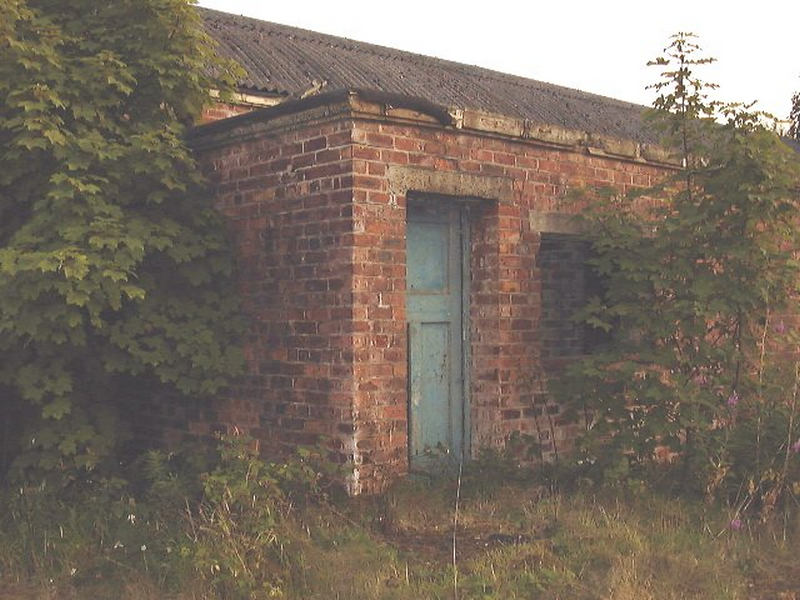 The 2 parallel dining rooms east-facing elevations are in in the background,
The 2 parallel dining rooms east-facing elevations are in in the background,
to the left, can be seen the spine corridor with its side small rooms.
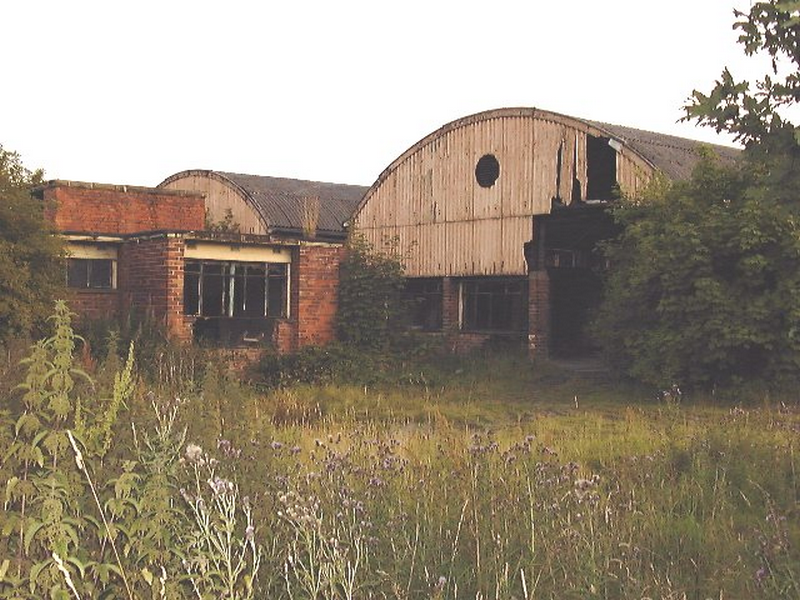 Looking south the spine corridor is in the middle
Looking south the spine corridor is in the middle
and the 2 parallel dining halls are on the right
 Looking northeast left to right are the kitchens,
Looking northeast left to right are the kitchens,
dining hall, theatre, and the tower block.
 Looking west from one of the large rooms in the bar area, to the right,
Looking west from one of the large rooms in the bar area, to the right,
can be seen the spine corridor with a gravity water supply tank
above and in the background are the 2 parallel dining halls.
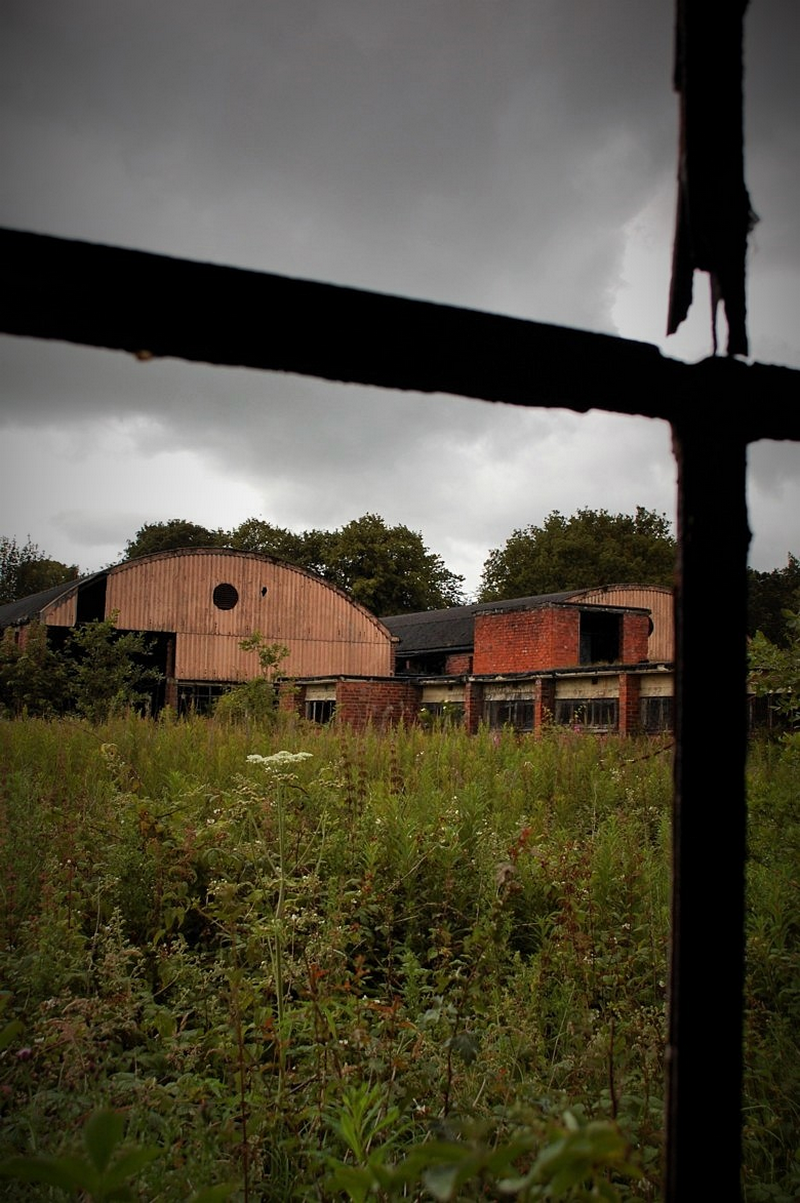
looking west from the roof of the bar area in the foreground can be seen the spine corridor
with small rooms on both sides and in the background are the 2 parallel dining halls.
The spine corridor and single-storey rooms are constructed of brick in stretcher bond
supporting a reinforced concrete flat roof covered with asphalt/bitumen for water proving.
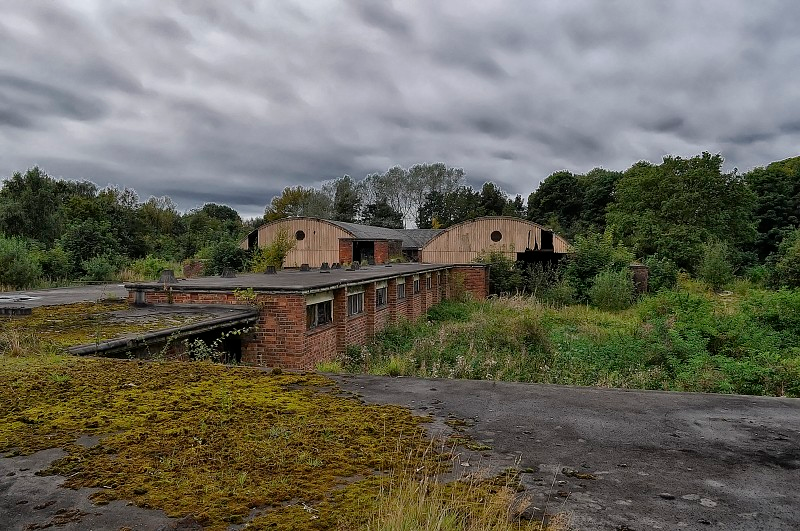 Looking east is the roofs of the 2 parallel dining halls,
Looking east is the roofs of the 2 parallel dining halls,
in the background are the cinema and tower block.
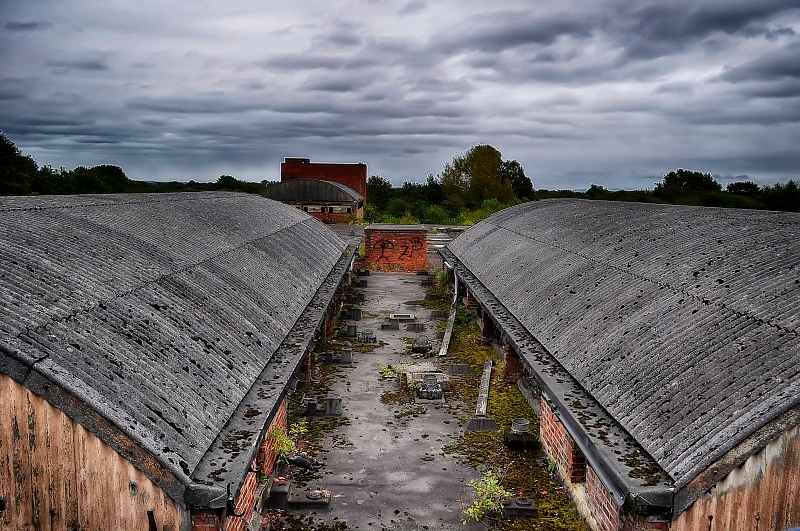 Inside the spine corridor with a small
Inside the spine corridor with a small
room leading off on both sides.
 The spine corridor had no natural light but the
The spine corridor had no natural light but the
small rooms on each side of the corridor had some windows.
 Large room from the north, there are 2 large rooms
Large room from the north, there are 2 large rooms
joined together extended south from the bar area.
The 2 large rooms have plenty of natural light with the
side walls lined with multi-metal framed windows.
We are not certain what the purpose of these 2 rooms
was for, but we think they were for lounges/restrooms.
We also think that these 2 rooms were training
classrooms during the Royal Naval period in WW2.
 Large room from the south
Large room from the south
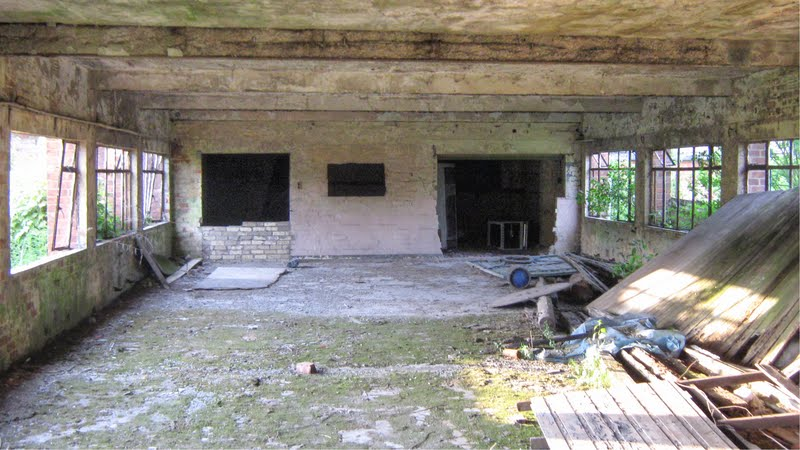 Large room again from the north.
Large room again from the north.
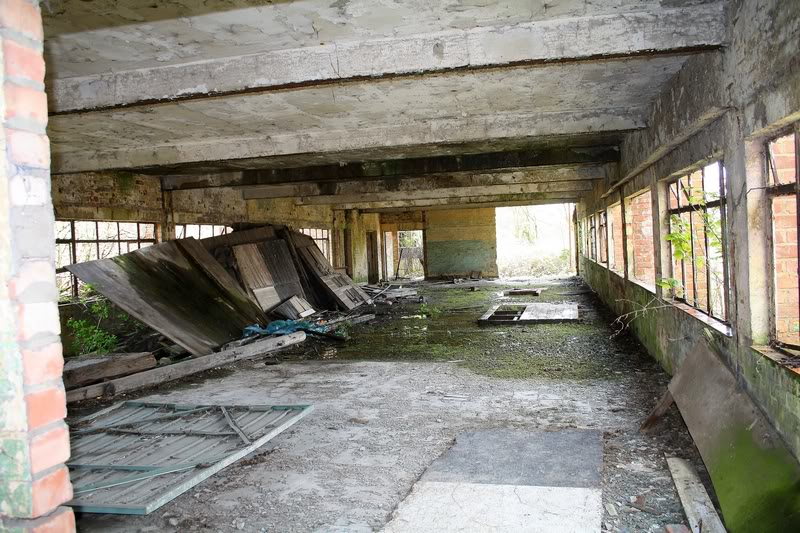 Latrine in the bar area
Latrine in the bar area
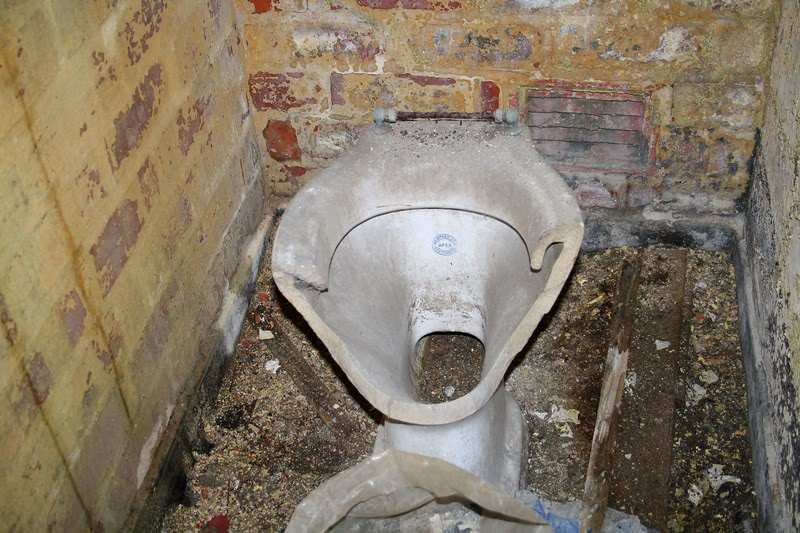 Latrine in the bar area, with the spine corridor leading off.
Latrine in the bar area, with the spine corridor leading off.
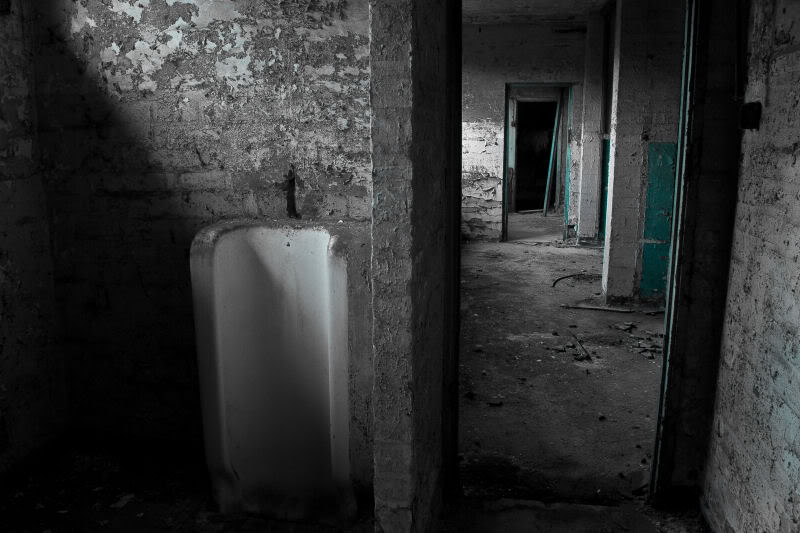 Main kitchen area.
Main kitchen area.
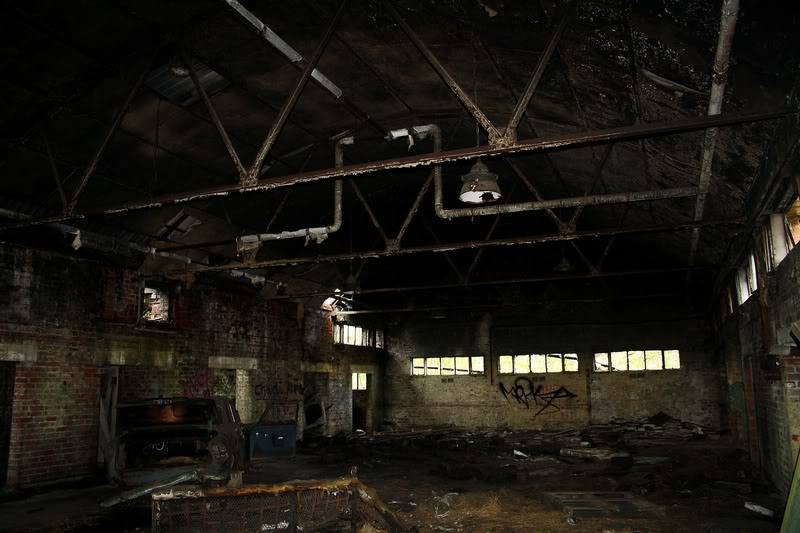 Kitchen serving hatches.
Kitchen serving hatches.
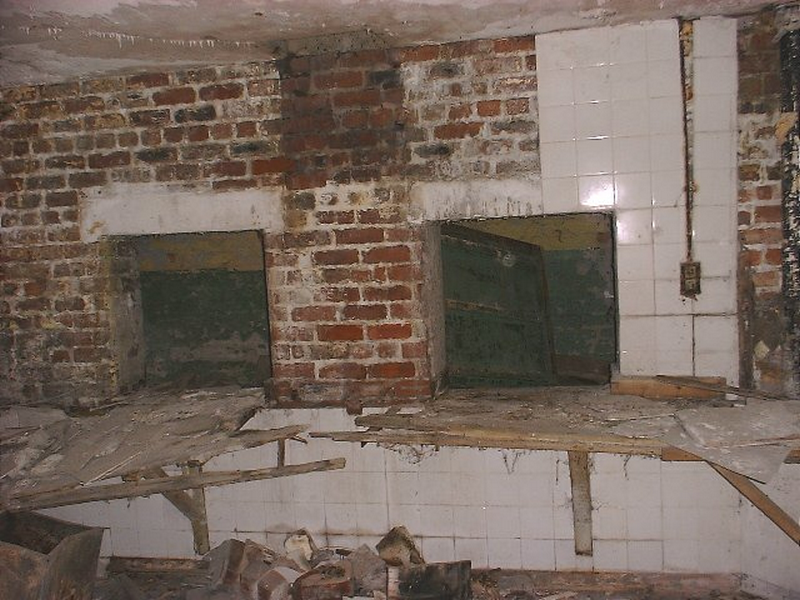 Dining Hall
Dining Hall
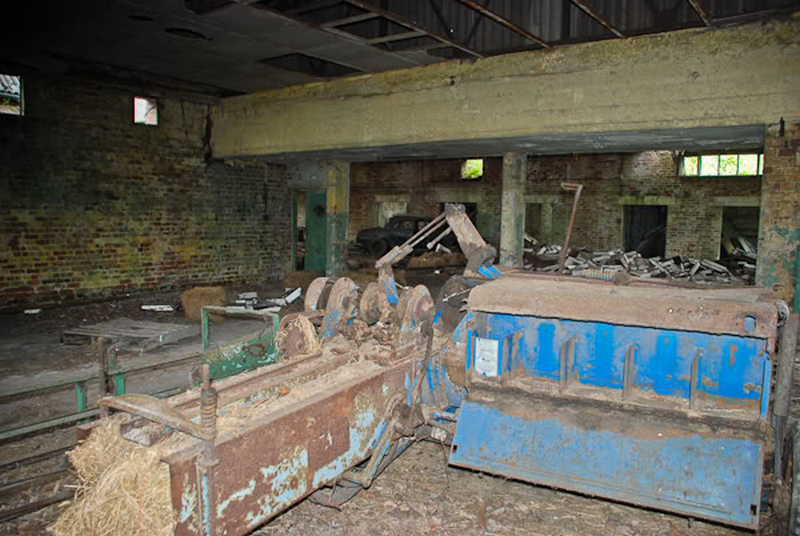
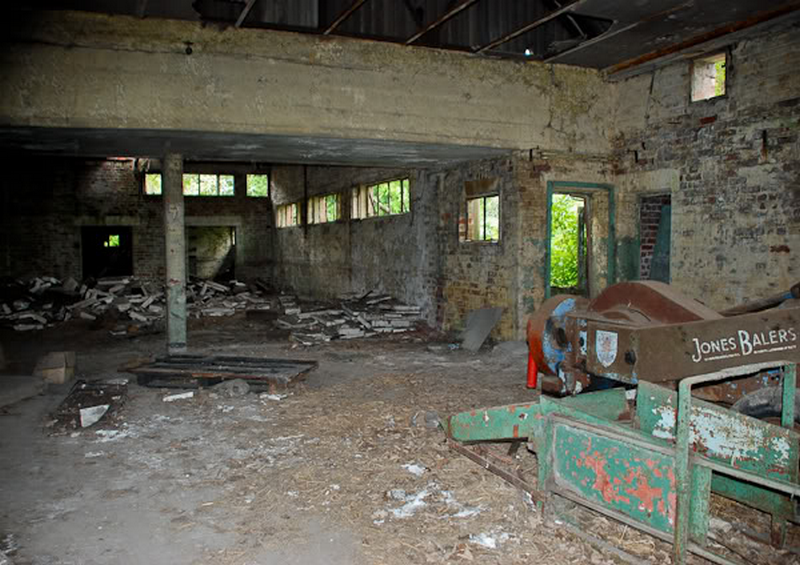
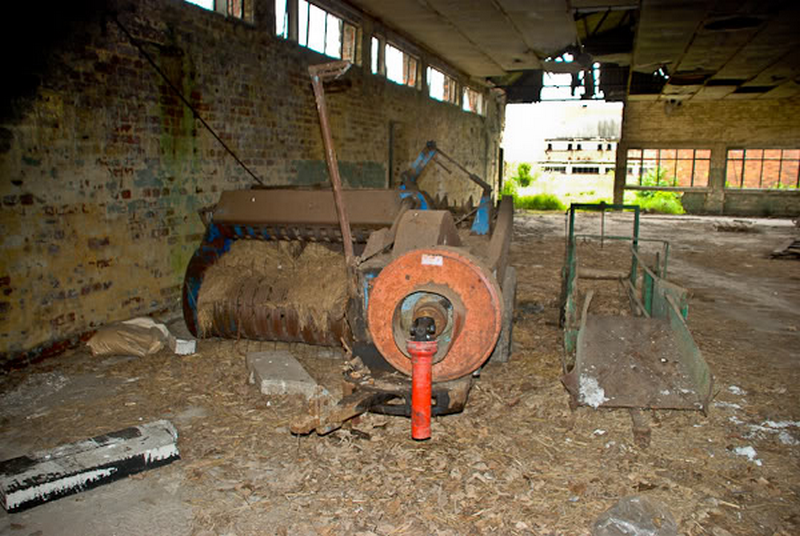
Bar area and serving hatch area, adjoining
the west elevation of the theater and cinema.
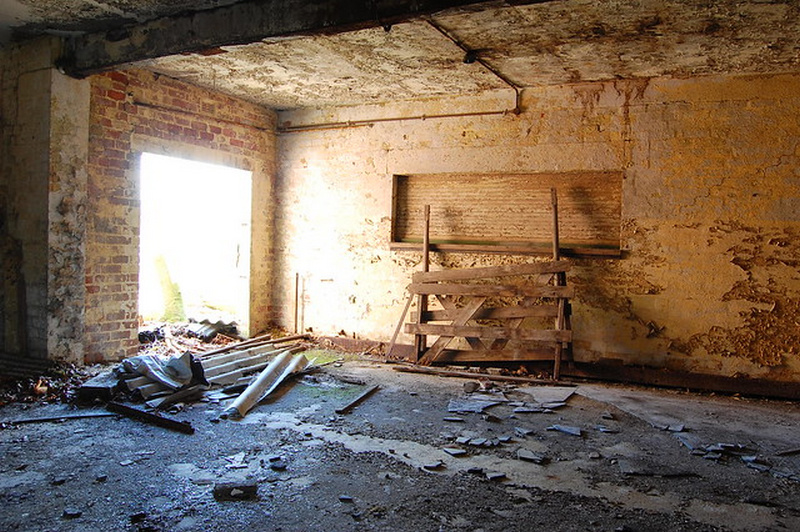
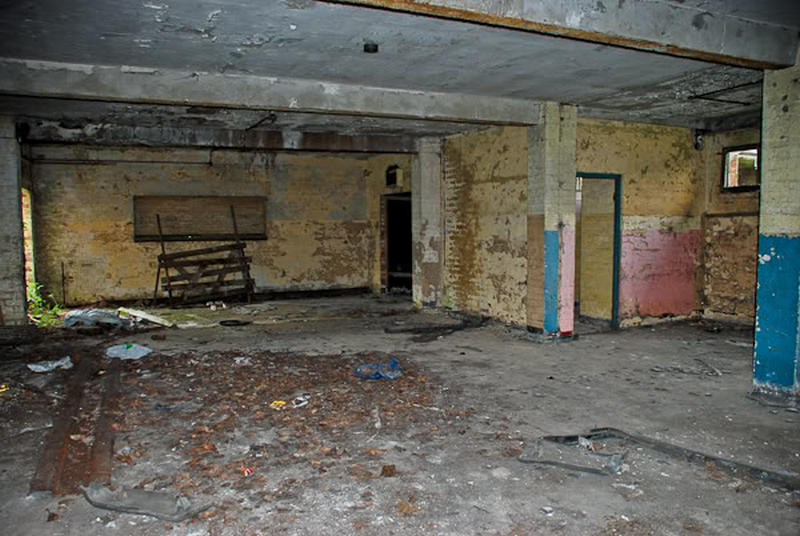
North elevation of the theater and cinema building
with the tower block building in the background.
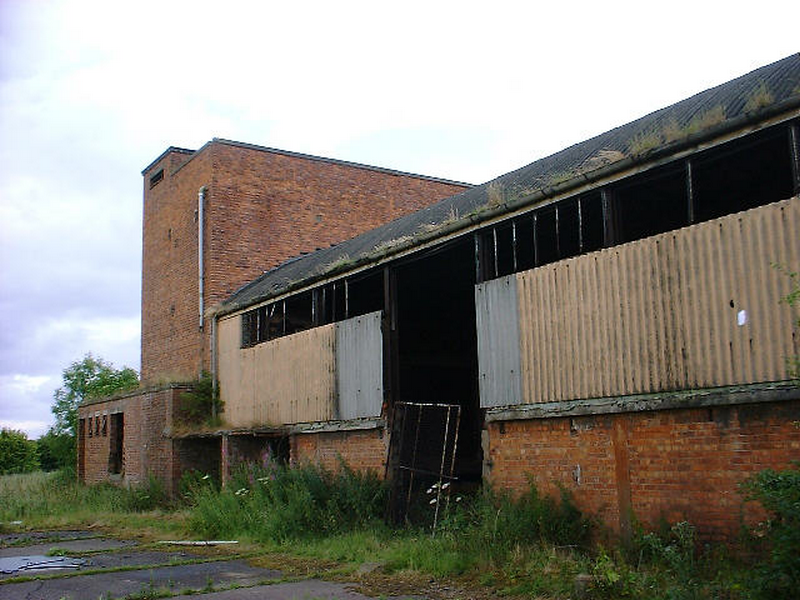
South elevation of the theater and cinema building with the tower block building to
the right To the left of the photo can be seen the east elevation of the large rooms.
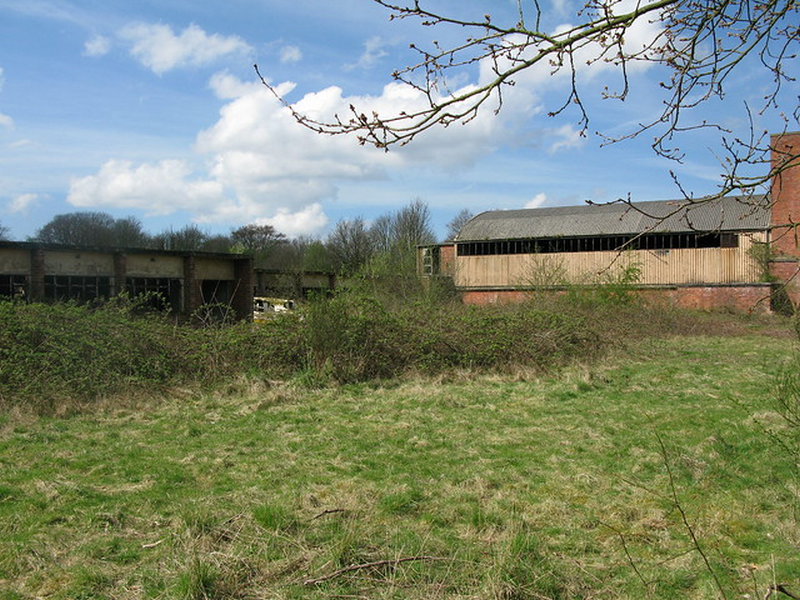
Looking east in the foreground can be seen the bar area,
with the theater/cinema and tower block behind.
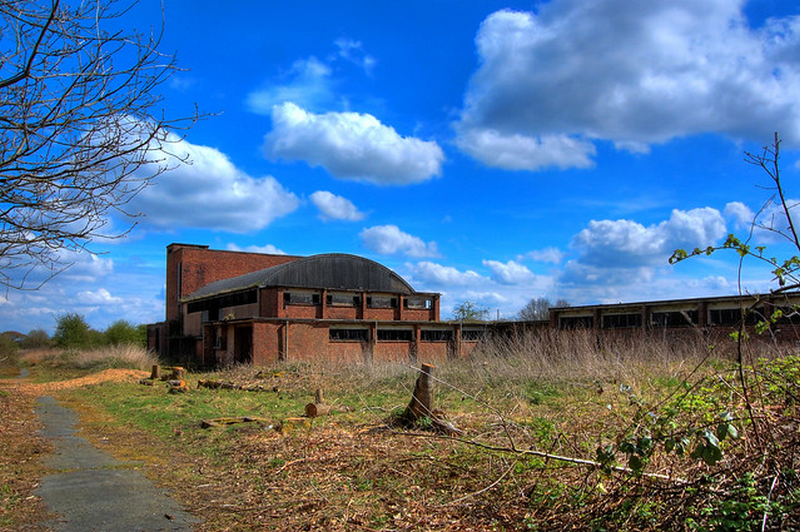
Looking from the roof of the bar area towards the
theater/cinema with the brick tower block to the right.
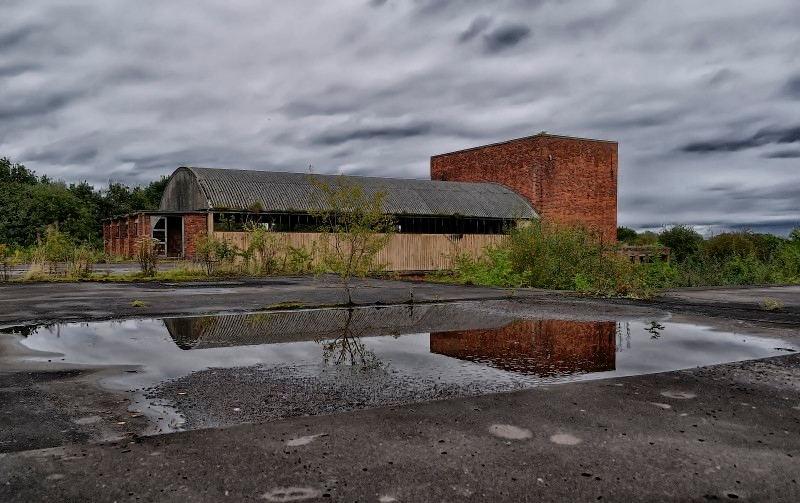
Inside the theater/cinema building towards the stage looking east,
this building was also used as a dance hall fitted with woodblock flooring.
 The cinema building is to the left looking east, this
The cinema building is to the left looking east, this
building is constructed to the same design as
the kitchen and dining halls buildings.
All 4 of these buildings had a curved profile roof, also a steel-framed
suspended ceiling fitted above window height and infilled with
sheet panels was also instaled to these type of building.
 Looking up inside the brick tower block, as you can see
Looking up inside the brick tower block, as you can see
the steel ladder is unusable to gain entry to the roof.
As an example of the roof detail of the tower block
building, the following 5 photos are taken at the
nearby Royal Navy Gosling camp 5 at Glazebrook.
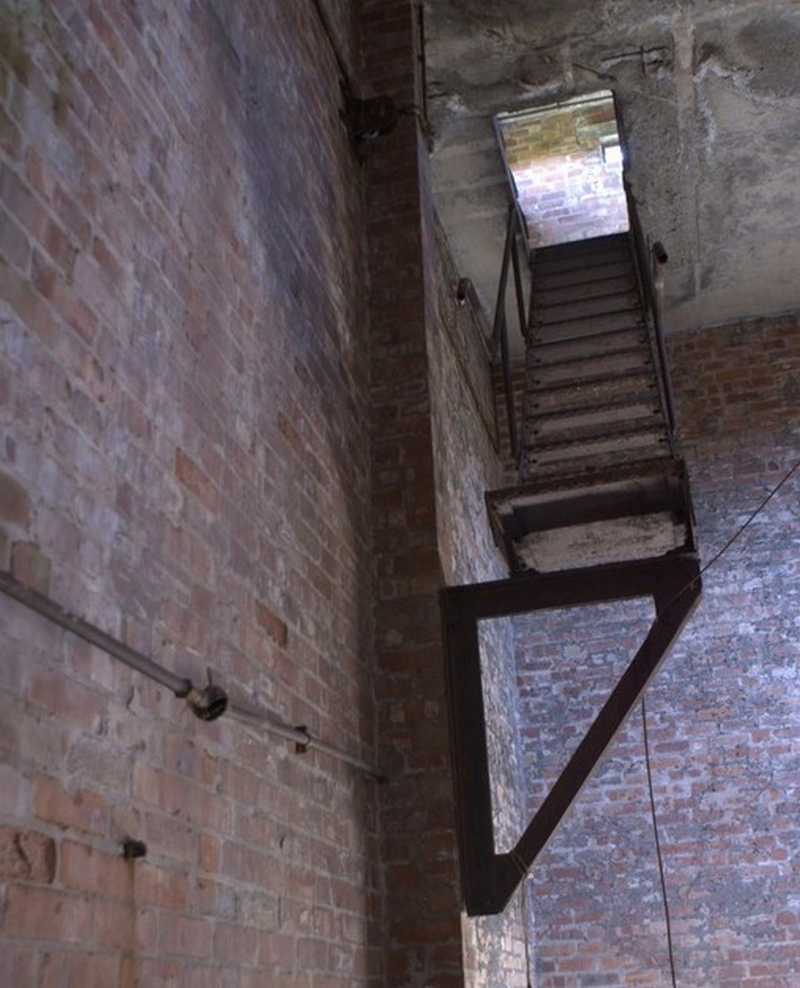 Not Croft but an example of the same identical tower
Not Croft but an example of the same identical tower
block at Royal Navy Gosling camp 5 at Glazebrook.
This camp is abandoned after being
used as Glazebrook country club.
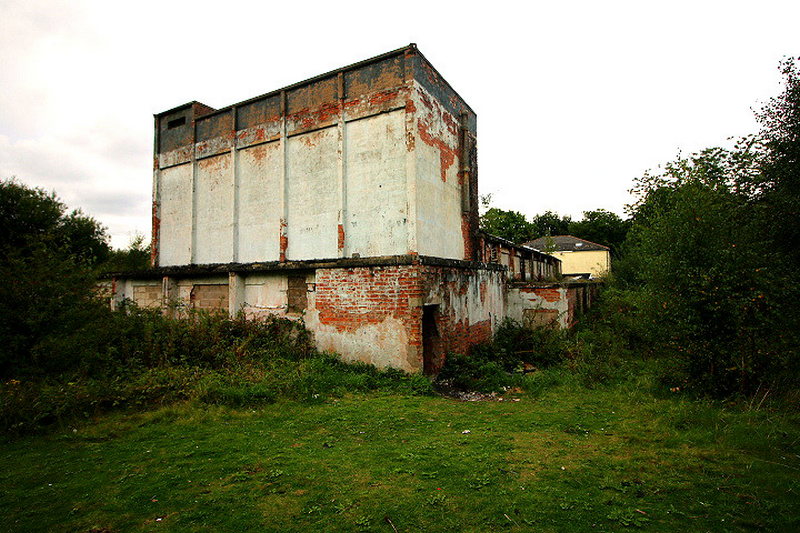
Detail of the inside of the tower block with the steel
staircase leading up to the roof lobby at Glazebrook.
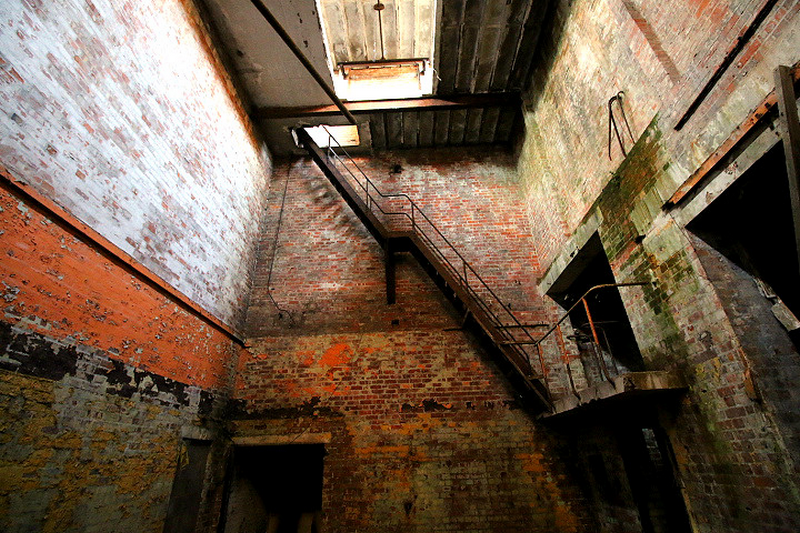
Top of the steel stairs entering
the roof lobby at Glazebrook.
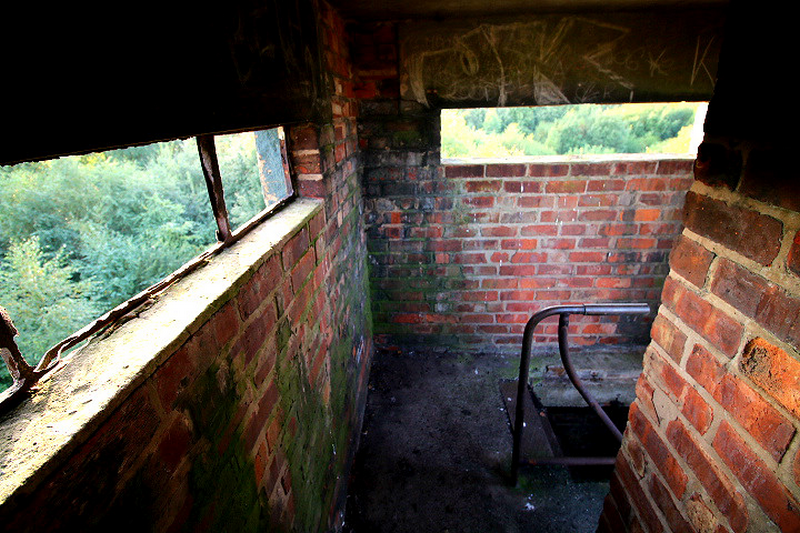
Detail of the building on top of
the tower block roof at Glazebrook.
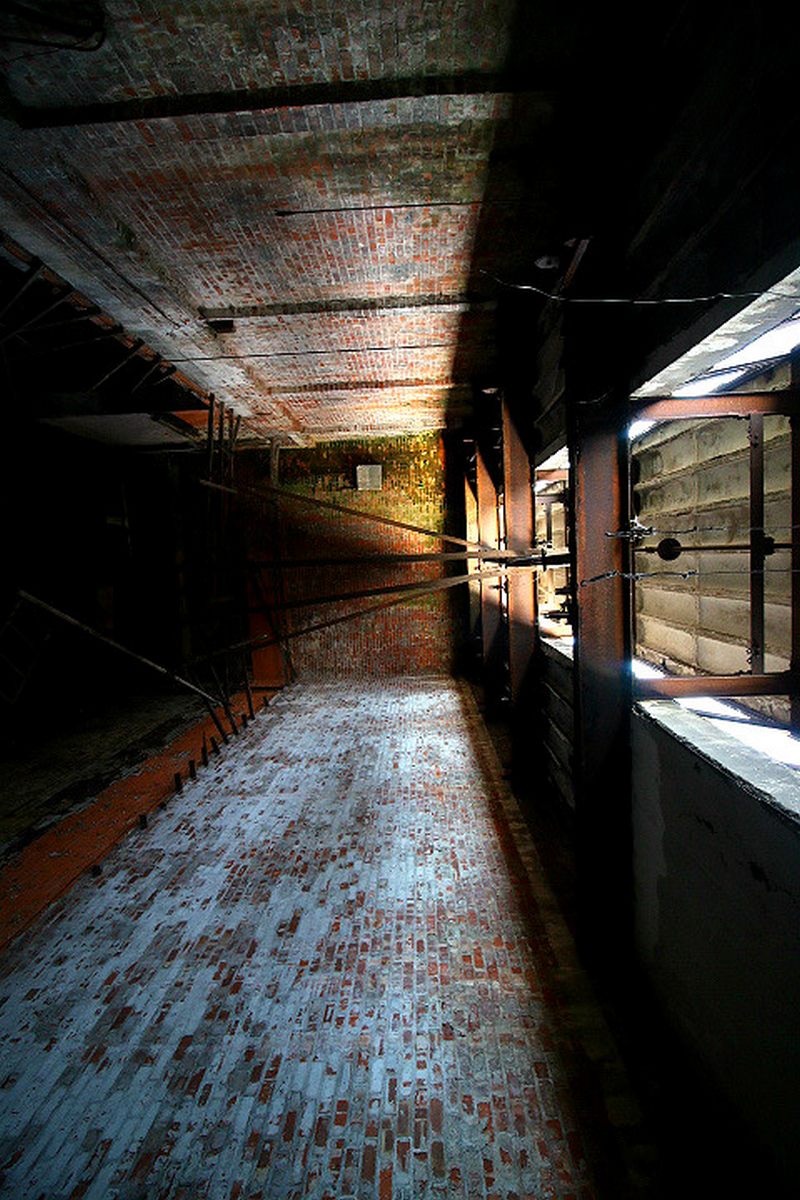
Tower block roof detail from above, the apex roof in
the foreground is the cinema at Glazebrook.
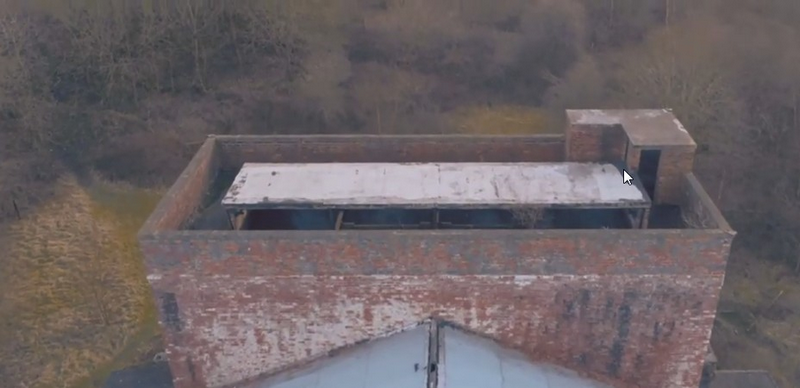
Aerial image of RAF Croft HMS Gosling camp
2009 before new housing estate is built.
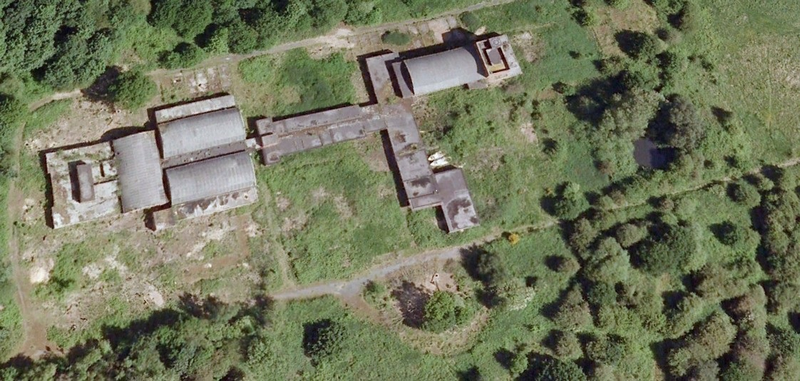
Aerial image of the site of HMS Gosling
camp Croft with new housing estate 2017.
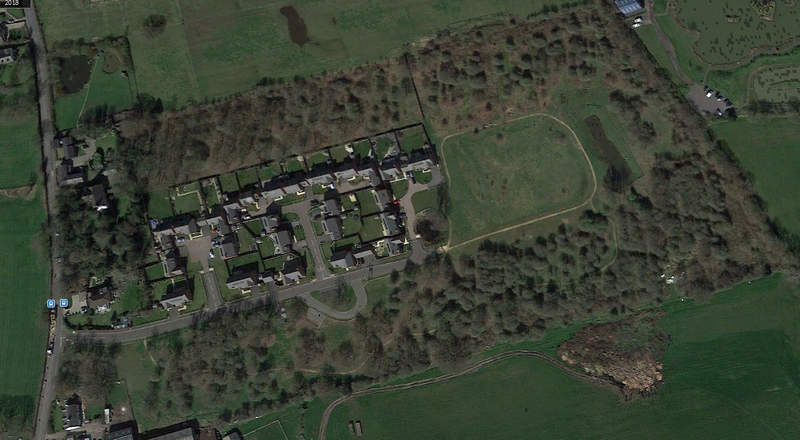
The 2019 photo below shows the new road entrance
(Emerald Drive) that leads to the new housing estate
(above 2017 photo) now built on land that was where
HMS Gosling camp RAF Croft
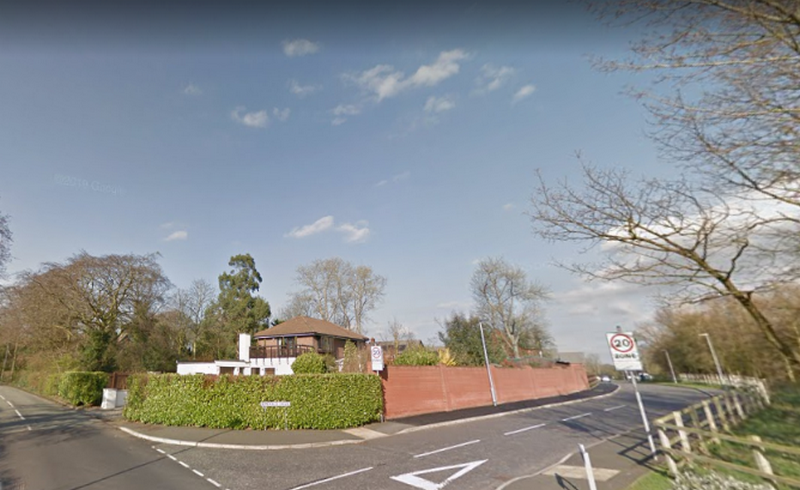
Bill Doyles ... served at RAF Croft in the 1950s this
his account and the activities of his time there
What I knew as RAF Croft started as additional living accommodation for H.M.S. Gosling located at Risley. H.M.S. Gosling was commissioned on 8 October 1942 and was paid off in 1946. That station was dedicated to the Fleet Air Arm and was a training base. H.M.S. Aeriel was also paid off and on 1 February 1956 was opened up as RAF Croft to process people in and out of the U.K. Although it was called RAF Croft it should not be confused with another RAF Croft which was up north and used by the RCAF during the war.
The base mission was to include billeting, feeding transients and coordinating movements with U.S. units in England and Scotland. According to the 1958 Burtonwood yearbook, the yearly average was around the 60,000 mark. At that time Burtonwood was the major airhead for the U.K. I believe that the base was capable of accommodating around 400 people but many were processed straight through and others only stayed one night. Services were limited but there was a small snack bar for sandwiches and beer, a movie theater, nursery and of course the mess hall which was open 24 hours a day to handle late arrivals and departures. We even had a civilian taxi which operated out of the base. Jack Higham was there most days and did quite a bit of business between the base and Warrington as well as Manchester. The best part of it was that Jack would grant credit to a permanent party when the end of the month was looming.
We were certainly a mixed bag when it came to permanent party and transients. Almost anybody who had some military connection and flew MATS (Military Air Transport Service) came through. USAF, U.S.N. USCG, Exchange People, civilians working on missile programs and of course dependent wives and children. Later on, when I worked in the ATCO in Mildenhall I found that we shipped twice as many people out as we shipped in. It must be all that cold and fog which caused part of the increase in dependents but I don?t think that many single military types made it out of England without a wife if they served a full tour.
Base personnel was a mixed bag as well. Local people came on the base to work in the offices, to do the cleaning and other various duties. Although Det 1, 7500th Air Base Group was the parent unit when it came to processing the passenger there were also men from the 1625th Support Squadron. It was pretty much of a self-contained base with our own air police, cooks, bakers, air passenger specialists, finance, postal, civilian firemen, supply et al. We even had a full-time civilian worker from American Express to run the money exchange. She lived on base to provide 24-hour service for transients when they came through. People would come in with greenback dollars to exchange for pounds and Mickey mouse money (Script).
Given the weather is a greater factor in those days and no direct flights from the states without refueling stops for the propeller aircraft of the time, the base did not always run smoothly in the processing of passengers. Fog and weather determined the ebb and flow of passengers. If Burtonwood was fogged in several things could happen. Croft could be full of people waiting for the weather to change so they could get back to the Z.I. As good as the facilities were they still were not equivalent to a large base or your permanent station. If the weather was persistently bad transients would be held at their home base until time to move. An empty base would give the shift workers a good break until traffic came through again. Someone could correct me if I am wrong but I think most of the passengers were airlifted by C-118s, along with a few C-97s and C-121s. I also think that a good bit of the cargo was carried by Old Shaky the C-124. Since I was not stationed at B/Wood the aircraft were not really noted. Civilian contractors flying for MATS would probably fly DC-6s and 7s. Never really trusted them as the contracts were awarded on the lowest bid per seat mile. Some of them looked distinctly war-weary by the time they landed up with a 3 aircraft airline with a name (fictitious) like Podunk Air Service.
There was also a movie theater and Charlie Quirk ran it in the evenings. When there were a lot of transients on the base the movie would fill up and Charlie would get paid. On those rare nights when the base was empty he would organize a few of the permanent party to pay a dollar to up the numbers where he could show the film and get paid. On those days when there were plenty of patrons, we had free movies.
Since Croft was a 24hour seven day week operation there were more shift workers than days workers who worked to my advantage. As a Staff Sergeant, the only extra duty I had was Mess Check and that came up pretty often. It was more complicated than the usual check as most of the people had to pay for their rations instead of having a mess pass. Quite a bit of money changed hands and it all had to be accounted for. If you had a shortage you had to make it up out of your pocket. If you were over you wondered how you manage to short change someone. As a day worker, I would switch with someone who had to work weekends so I could have a free weekend.
Another advantage of Croft was that it was not too far away from Padgate Teachers College which was packed with a hundred or two hundred trainee teachers and one lone male. It was happy hunting ground and I got caught early meeting my future wife of 39 years only 21 days after arriving in May. She graduated in June or July and I had already told her that I was going to marry her. Our reputation was not too great at the college and she insisted I show her proof that I was single. My last discharge was in Hawaii and my DD 214 said that I had no dependents so that settled her down. Proving you were single is difficult. Anyway courting her was more important than staying on base. Being in Administration meant that I was not actively involved in passenger movements so some of my observations may be off or superficial.
The new British wives came in all shapes and sizes but they had to be pretty brave to latch up with an airman, have kids with them, and at the end of the tour head for another country. I did hear of some that bailed out at the last minute before heading up the ramp to the aircraft but did not witness that myself. There were a few reactions to the food in the mess hall though. Corn (Indian type) was not common to the U.K. then and some of the women thought that it was pretty rude to feed them stuff which was normally fed to the pigs. I'm not too sure what they thought of the food generally but the troops thought it was a pretty good mess hall. Msgt Sims was the mess sergeant and he later (I think) was sent down to run the officer's mess at Lancaster Gate.
Commercial buses ran between Burtonwood, Croft and Bank Quay station. For some bases hired buses transported people within the U.K. There was a bus turnaround with a flag pole in the center and during one foggy night, an Air Policeman found a slightly drunk airman following the curb trying to find his barracks. He spent about 20 minutes going round in circles. On really foggy nights coming out of the snack bar, the building lights faded out after about 20 feet and nothing could be seen beyond that. My technique was to walk out the door and turn left about 30 degrees and I knew then that I would bang into the building that I lived in.
The barracks were frame structures with brick entrances that looked like they were designed as partial bomb shelters to deflect the blast. I might be wrong but the brickwork?s may have enclosed the bathroom and showers. There was even a bathtub in there. On a damp and cold night, a good soak would ease the weary bones. I vaguely recall that my room even had a sink and mirror and to top it off we had radiators and steam heat from a central power plant. I understand that the quarters for the transients were similar but I never wandered over that side of the base. Saw enough of the people coming through in the mess hall, in the snack bar, and other places. These particular structures were called Butler Buildings and bore no resemblance to a Quonset or Nissen hut.
Some of the airmen on base had bicycles and made it around that way but as soon as possible I bought a clapped out 52 Hillman which was enough to get me down to Madeley Near Crewe where my girlfriend lived with her parents and started teaching in Newcastle. My future mother in law cautioned her to expect me to drop off as 40 miles was a long way. Six years later when I finished up a tour in Korea and traveled more than halfway around the earth to rejoin my wife I asked the mother-in-law if she still thought 40 miles was a long way for me to travel. The Hillman was o.k. for local travel but when I got transferred to Mildenhall it couldn?t make the distance. The engine blew up outside Alconbury.
Since the unit received more than its fair share of welfare funds we were able to have things paid for by the unit rather than coming out of our pockets. According to the morning report, we were a four or five hundred man unit. It may have been more as we probably picked them up when they arrived but did not drop them until they were picked up by the next unit. On 4 July 1958, we had a squadron party at Bell Vue Park in Manchester. I don?t know what it is now but it was a fun park in those days with roller coasters, sideshows, bumper cars and the lot. There must have been more than a hundred people there with the unit. Had our own tent with food provided by the mess hall, beer and soft drinks and almost unlimited ride tickets. The star attraction for some of the men who had a few beers was the bumper cars. Head-on collisions were the order of the day and I think that one of the men came out of it with a chipped vertebrae. About two weeks after the event I went down there to settle up with the park. The man who was still repairing his cars was not keen on having us show up again.
We also had the opportunity to go down to Manchester to see some of the plays and shows down there paid from the squadron funds. By American standards, they were pretty racy and I remember the double and triple meanings to the jokes. I especially remember one with Dickie Dawson who at the time was married to Diana Dors or Jane Mansfield. Lots of jokes about large chests in that one. The unit also sponsored a bowling team held at Burtonwood. With that sort of money available we could also hire a band and hold dances which attracted a good many local girls. In the self-funded area there was a lot of betting on the horses and dogs.
It wasn?t all sweetness and light though as there was some skullduggery going on all the time. My first introduction was when the Base Sergeant Major ran down a list of people on the base. Who to associate with-who to avoid, who to trust and not trust. My first impression was that he was a bit paranoid but I?m glad I followed his advice. My training under MSgt Don Brown really helped me throughout my career. The crap really hit the fan about two or three months before the base closed. There were all sorts of allegations and Croft became an item of interest to the tabloids. Not too sure of who was doing what but will not mention names as some of the participants may still be around. There were a lot of visitors from the Auditors, from the Adjutant Generals Office as well as from the O.S.I. One day I asked one of the agents what he was looking for? His reply was "This place is a bucket of worms and I?m waiting for some of the worms to stick their heads up." There was a lot of smoke but from what I?ve learned over the years was that not many people got seriously hurt over the allegations. What I did know at the end was that everyone connected with the base was eager to get the hell out of there. I do remember Lt Wilson, who stood pretty tall in my books, ordering me to type up a Special Order relieving the Commander and placing him in command. I had never done one of those orders before but figured it out from the manual. All I could think of was "shades of the Caine Mutiny".
Anyway when flying operations closed at Burtonwood and passengers were processed through Mildenhall the system changed quite a bit. As most of the bases were in the south it was possible to have them check in four hours before the flight for most of them. Personnel from Croft were scattered far and wide although around 10 or 12 of us were sent to Mildenhall where we were designated as the USAF Air Traffic Coordinating Office. This unit controlled the flow of passengers and cargo through Mildenhall as well as manning the check-in an weighing of baggage.
Phasing down the base took some time as all the property had to be turned in to supply at Burtonwood and the barracks etc. had to be left in pristine condition. We must have burned at least ten tons of trash. At the end, there were only three of us left. The mess was long gone so we got $5 per day or something near that so we ate pretty well even if it was mainly fish and chips. We moved into the guardroom at the front gate until it was time to turn over the base to the RAF. All of our work cleaning up the base was for nothing. When I visited the base in 91/92 The mess hall was full of chickens and all the barracks were gone. The only trace of the barracks were the floor tiles on the ground. Other buildings held farm machinery and the base probably will be bulldozed out of existence when the developers need the land for housing.
credit to Bill Doyles.
|





